Beijing, Great Wall, Beijing Duck - Saturday, July 14, 2001
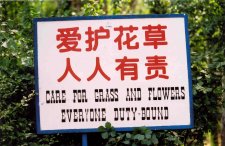 We got up entirely too early . . . 6:00 a.m. . . . and had breakfast in the
hotel. Probably the worst breakfast on the trip. We were sequestered in a
little room away from the rest of the patrons and served yogurt, bread, and
a fried egg. There was also the Chinese buffet in the main room.
We got up entirely too early . . . 6:00 a.m. . . . and had breakfast in the
hotel. Probably the worst breakfast on the trip. We were sequestered in a
little room away from the rest of the patrons and served yogurt, bread, and
a fried egg. There was also the Chinese buffet in the main room.
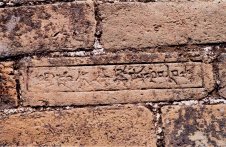 After breakfast we headed to the great wall. The great wall started as a
number of individual walls around several of the seven Chinese kingdoms
prior to unification. Today, there are different sections of the wall,
some that have been restored, but many are in ruins or missing sections. The
wall is not made of stone, but instead of bricks. The bricks were specially
made and fired seventeen times. The bricks are extremely strong and durable.
Villagers removed bricks in a lot of places in order to make other buildings.
In some sections the bricks are signed by maker. If bricks in a section failed
prematurely, the officials would know who was responsible for the faulty bricks.
After breakfast we headed to the great wall. The great wall started as a
number of individual walls around several of the seven Chinese kingdoms
prior to unification. Today, there are different sections of the wall,
some that have been restored, but many are in ruins or missing sections. The
wall is not made of stone, but instead of bricks. The bricks were specially
made and fired seventeen times. The bricks are extremely strong and durable.
Villagers removed bricks in a lot of places in order to make other buildings.
In some sections the bricks are signed by maker. If bricks in a section failed
prematurely, the officials would know who was responsible for the faulty bricks.
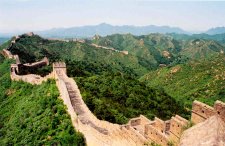 The most popular section of the wall is close to Beijing, has a McDonalds, and
has been restored so that it is easy to walk. It is also frequently mobbed by
tourists. We went to a section about three hours west of Beijing and there were
very few people there. You have to buy tickets to walk each section of wall,
and we walked two separate sections. Who knew? a toll wall! In addition to
charging ¥0.5 for toilets, locals provided the normal array of souveniers, water,
and soft drinks, and acted as "helpers." The helpers were locals who walked along
the wall with you, pointed out detours, interesting vistas, and showed you pictures
of where you were in books and on postcards. As luck would have it, they would
also sell you these items! Each helper attached him or herself to one walker,
except for Ian, who they knew from prior visits.
The most popular section of the wall is close to Beijing, has a McDonalds, and
has been restored so that it is easy to walk. It is also frequently mobbed by
tourists. We went to a section about three hours west of Beijing and there were
very few people there. You have to buy tickets to walk each section of wall,
and we walked two separate sections. Who knew? a toll wall! In addition to
charging ¥0.5 for toilets, locals provided the normal array of souveniers, water,
and soft drinks, and acted as "helpers." The helpers were locals who walked along
the wall with you, pointed out detours, interesting vistas, and showed you pictures
of where you were in books and on postcards. As luck would have it, they would
also sell you these items! Each helper attached him or herself to one walker,
except for Ian, who they knew from prior visits.
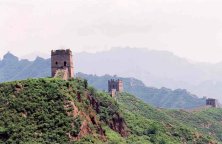 It was a beautiful day, sunny but not too hot. I realized that I had forgotten to
remove my umbrella from my backpack and Ian said he would carry it. He had just
gotten a haircut, and thought it a good idea to keep his scalp in the shade. We
set off on a leisurely six-mile stroll along the wall. We were heading uphill for
most of the first three quarters of the trip.
It was a beautiful day, sunny but not too hot. I realized that I had forgotten to
remove my umbrella from my backpack and Ian said he would carry it. He had just
gotten a haircut, and thought it a good idea to keep his scalp in the shade. We
set off on a leisurely six-mile stroll along the wall. We were heading uphill for
most of the first three quarters of the trip.
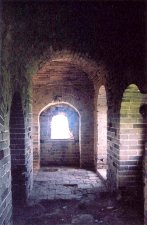 The wall tended to go along the crest of the hills. It seemed almost ludicrous to
have a 12'-20' high wall on top of some of these hills. If you could make it up the
hill, the wall should be no problem. There are towers every 100-200 yards, about
25,000 in all. The towers have a couple of guards and a few had gates in them as
well.
The wall tended to go along the crest of the hills. It seemed almost ludicrous to
have a 12'-20' high wall on top of some of these hills. If you could make it up the
hill, the wall should be no problem. There are towers every 100-200 yards, about
25,000 in all. The towers have a couple of guards and a few had gates in them as
well.
After about 45 minutes, one of our helpers gave up on us and Anne and I had to share
a helper. He was really pretty cool. He showed us the sights and pictures of the
towers in a book he had for sale, but didn't bother us with incessant sales pitches.
After a particularly steep section, we stopped for lunch. We had covered a little
less than half of our walk, but a lot of the climbing. We looked back down to where
we had started and it didn't seem that far. We could see the wall snaking across the
hills and eventually slipping over the horizon. It looked so small compared to the
hills.
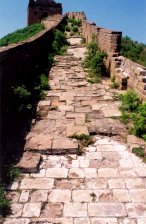 After lunch we continued up to the top of a ridge and along the crest. This did not
mean that the climbing was over. The wall seems to sag between towers as it ventures
down into valleys between the ridges. The wall itself is made up of different layers
of bricks, which head in different directions or are different sizes and colors. Our
helper told us that the grey bricks are new, only about twenty-years old. The lighter,
off-white bricks are about 400 years old.
After lunch we continued up to the top of a ridge and along the crest. This did not
mean that the climbing was over. The wall seems to sag between towers as it ventures
down into valleys between the ridges. The wall itself is made up of different layers
of bricks, which head in different directions or are different sizes and colors. Our
helper told us that the grey bricks are new, only about twenty-years old. The lighter,
off-white bricks are about 400 years old.
Some of the sections of the wall, especially as we got farther along, were in a state
of disrepair. Often, wild flowers grew up through the bricks, sometimes almost blocking
the path. Toward the end, with only about ten towers to go, our helper pointed to a path
and suggested that we detour around the next tower. We declined, and he told us that
there was a big drop from the doorway on the other side of the tower. We were not,
however, dissuaded. Sure enough, the far door on the tower was disconnected from the
wall and you had to jump several feet from the doorway to the path. Anne, eventually,
jumped and then I handed my camera to our helper and jumped myself.
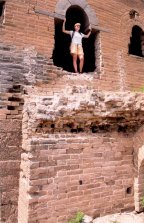 Before the next tower there was another path, which we also declined to take. This
time there was a 10'-12' drop after the tower. Once again, I handed my camera to our
helper and climbed down, then Anne climbed down. The wall between the third-to-last and
second-to-last towers was mostly gone. We went into the third-to-last tower, but were
forced to retreat along the detour to get to the next tower. The detour was rather
perilous as well.
Before the next tower there was another path, which we also declined to take. This
time there was a 10'-12' drop after the tower. Once again, I handed my camera to our
helper and climbed down, then Anne climbed down. The wall between the third-to-last and
second-to-last towers was mostly gone. We went into the third-to-last tower, but were
forced to retreat along the detour to get to the next tower. The detour was rather
perilous as well.
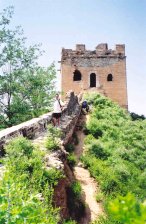 Finally, we made it to the end. We finished at a new section of the wall, which
would require additional funds to traverse. I wonder if the original creators of
the Great Wall would eever have imagined that the Wall would function better as a
tourist, toll-wall, then as a deterent to the Monguls? The big problem with the
Great Wall as a defense was its size. With 25,000 towers it takes over 50,000 guards
to provide even minimal coverage. And at least a couple of those guards would be
willing to take a bribe rather than try to fight off Mongul hoards.
Finally, we made it to the end. We finished at a new section of the wall, which
would require additional funds to traverse. I wonder if the original creators of
the Great Wall would eever have imagined that the Wall would function better as a
tourist, toll-wall, then as a deterent to the Monguls? The big problem with the
Great Wall as a defense was its size. With 25,000 towers it takes over 50,000 guards
to provide even minimal coverage. And at least a couple of those guards would be
willing to take a bribe rather than try to fight off Mongul hoards.
The last couple of towers, and wall between them, had been restored. After the last
tower there was a suspension bridge over what used to be a river or stream. Now there
is just a dry bed leading into a pond, with a dam at the end of it. On the other side
of the bridge were newly restored towers and some really steep stairs. Ian led
us along a footpath that was really quite treacherous. The path wound over hills and
gullies, across a 45° slope with water running down it, and through brush. It was
about one or two kilometers long, and made us wonder if it wouldn't have been better
to simply pay for the next section and bypass this little peril.
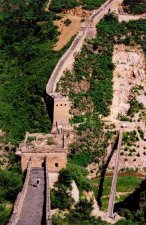 Our helper ditched us at the last tower after Anne got postcards, gourds, a picture
book, and bracelet for ¥100 ($12.50). This involved two towers worth of negotiations,
and Anne walking off with her money at one point. The helpers walk back to the start
of the section along a path.
Our helper ditched us at the last tower after Anne got postcards, gourds, a picture
book, and bracelet for ¥100 ($12.50). This involved two towers worth of negotiations,
and Anne walking off with her money at one point. The helpers walk back to the start
of the section along a path.
Overall the walk along the Wall was the high-point of the trip. The scenery, and the
Wall itself, were incredible. I took about 175 pictures, many through doorways and
windows in the towers!
 Across the suspension bridge was a ride. You got strapped into a harness and attached
to a tow-line. Then you zoomed down the tow-line for a couple of hundred yards, over
the pond and dam, ending near the end of our treacherous little path. Anne would
have really liked to have been able to go on that.
Across the suspension bridge was a ride. You got strapped into a harness and attached
to a tow-line. Then you zoomed down the tow-line for a couple of hundred yards, over
the pond and dam, ending near the end of our treacherous little path. Anne would
have really liked to have been able to go on that.
We got back to the bus and took advantage of the ¥0.5 toilets. I also got an ice cream
and some cool water. We got into the bus and headed back to Beijing. On the way, we
passed the new city they are creating for the Olympics. As previously mentioned, beijing
is both a city and a province. The Olympics will be held in Beijing province, and not
in the city itself.
 On the way to the Great Wall, Ian told us about China's reforestation project. It
is a result of a series of poorly planned projects by Chairman Mao. In an attempt to
increase crop production, Mao decided that it was necessary to get rid of all of the
birds. The theory was that the birds were eatting the seeds and/or crops, and that
by eliminating all of the birds, the crop yields would increase. So, Mao had people
go out into the woods with sticks and bang on the trees day and night so that the
birds could not roost. Apparently, when you have a couple hundred million people to
throw at a problem, there are all kinds of interesting solutions. This tactic worked
amazingly well and eliminated the vast majority of birds. However, as might be
imagined, there were some side effects.
On the way to the Great Wall, Ian told us about China's reforestation project. It
is a result of a series of poorly planned projects by Chairman Mao. In an attempt to
increase crop production, Mao decided that it was necessary to get rid of all of the
birds. The theory was that the birds were eatting the seeds and/or crops, and that
by eliminating all of the birds, the crop yields would increase. So, Mao had people
go out into the woods with sticks and bang on the trees day and night so that the
birds could not roost. Apparently, when you have a couple hundred million people to
throw at a problem, there are all kinds of interesting solutions. This tactic worked
amazingly well and eliminated the vast majority of birds. However, as might be
imagined, there were some side effects.
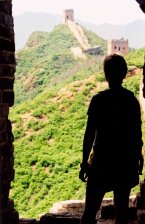 The major problem was that birds eat locusts, and without the birds the locust
population grew out of control. And of course, locusts eat crops. In fact, they
devastate crops, which is just what they did. In order to solve the locust problem,
Mao had people cut down all of the trees and other vegetation. Another problem
solved! Unfortunately, this led, possibly unsurprisingly, to erosion and severe
dust storms when the winds blew out of Mongolia.
The major problem was that birds eat locusts, and without the birds the locust
population grew out of control. And of course, locusts eat crops. In fact, they
devastate crops, which is just what they did. In order to solve the locust problem,
Mao had people cut down all of the trees and other vegetation. Another problem
solved! Unfortunately, this led, possibly unsurprisingly, to erosion and severe
dust storms when the winds blew out of Mongolia.
After Mao's death it was generally acknowledged that Mao did some great things for China,
but that some of his policies had not been carefully thought out. So, now China is
reforesting.
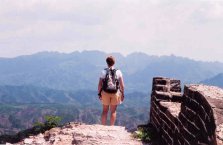 It only took us 2 hours to get back to Beijing, and the plan was to shower and change
and head out for Peking duck (now Beijing duck) at 8:00 p.m. At least we had two whole
hours and a working shower this time. When we arrived back at the hotel we headed over
to the Business Center to try to get in touch with our local guide and find out about
getting tickets to Hong Kong. Unfortunately, the Business Center was closed. So, we
headed up to the room and took showers. I came back after my shower and the Business
Office was open. I was unable to get in touch with our local guide, but I did talk to
Debbie about meeting the next morning. I also told Debbie about our airline crisis, so
she would be prepared in case we needed additional assistance on that front.
It only took us 2 hours to get back to Beijing, and the plan was to shower and change
and head out for Peking duck (now Beijing duck) at 8:00 p.m. At least we had two whole
hours and a working shower this time. When we arrived back at the hotel we headed over
to the Business Center to try to get in touch with our local guide and find out about
getting tickets to Hong Kong. Unfortunately, the Business Center was closed. So, we
headed up to the room and took showers. I came back after my shower and the Business
Office was open. I was unable to get in touch with our local guide, but I did talk to
Debbie about meeting the next morning. I also told Debbie about our airline crisis, so
she would be prepared in case we needed additional assistance on that front.
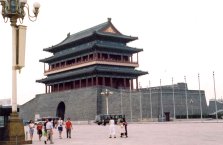 We caught a cab to the restaurant . . . or at least most of the way to the restaurant.
The driver decided that it would be a good idea to drive along the road immediately
south of Tian'anmen square. This resulted in our sitting in traffic for about 10-15
minutes before we eventually got out and walked the rest of the way. It took us about
20-30 minutes to walk, and we had to navigate back alleys in order to make it to the
restaurant.
We caught a cab to the restaurant . . . or at least most of the way to the restaurant.
The driver decided that it would be a good idea to drive along the road immediately
south of Tian'anmen square. This resulted in our sitting in traffic for about 10-15
minutes before we eventually got out and walked the rest of the way. It took us about
20-30 minutes to walk, and we had to navigate back alleys in order to make it to the
restaurant.
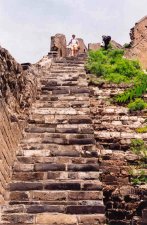 It was a little restaurant that seemed like it would be impossible to find, but it was
full. Apparently they have started advertising and it is a lot more crowded these days.
We ate outside in what appeared to be a courtyard of some sort. They bring out the
cooked duck . . . and I do mean all of it . . . and then slice lots of little pieces
off of it. You take a piece or two of duck and some onion-like things, dip them in plum
sauce, and then roll the whole thing into a little pancake. The duck was OK. Although
Sally and Ian thought it "brilliant" and "lovely." Of course, being that I am not a big
fan of food to begin with, what do you expect?
It was a little restaurant that seemed like it would be impossible to find, but it was
full. Apparently they have started advertising and it is a lot more crowded these days.
We ate outside in what appeared to be a courtyard of some sort. They bring out the
cooked duck . . . and I do mean all of it . . . and then slice lots of little pieces
off of it. You take a piece or two of duck and some onion-like things, dip them in plum
sauce, and then roll the whole thing into a little pancake. The duck was OK. Although
Sally and Ian thought it "brilliant" and "lovely." Of course, being that I am not a big
fan of food to begin with, what do you expect?
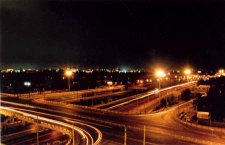 After dinner, Sally and I caught (eventually) a cab back to the hotel, while Anne and
Ian walked. I was getting a little tired of walking and had produced a couple of rather
nice blisters on my feet, which I did not want to exacerbate. I also wanted to check my
E-mail before going to bed.
After dinner, Sally and I caught (eventually) a cab back to the hotel, while Anne and
Ian walked. I was getting a little tired of walking and had produced a couple of rather
nice blisters on my feet, which I did not want to exacerbate. I also wanted to check my
E-mail before going to bed.
The Internet place was about a 15-minute walk from the hotel. It cost ¥6 ($0.75) per
hour charged in half-hour segments. I got a note back from Becca that she had also
made Law Review. Sweet!! I was online for 30 minutes and handed the guy a
¥5 note. He was unable to find change, so I just left. Oh no, I lost $0.25. It
took Anne and Ian about an hour to walk back from the restaurant at high speed. Our
plan was to have breakfast at 8:00 a.m. and then attempt to get airline tickets. Then
we would meet Debbie at our hotel at 10:00 a.m.
| Home | China Journal |
© 2001 John Eisinger. All rights reserved
Please report any problems to me.
 We got up entirely too early . . . 6:00 a.m. . . . and had breakfast in the
hotel. Probably the worst breakfast on the trip. We were sequestered in a
little room away from the rest of the patrons and served yogurt, bread, and
a fried egg. There was also the Chinese buffet in the main room.
We got up entirely too early . . . 6:00 a.m. . . . and had breakfast in the
hotel. Probably the worst breakfast on the trip. We were sequestered in a
little room away from the rest of the patrons and served yogurt, bread, and
a fried egg. There was also the Chinese buffet in the main room.













